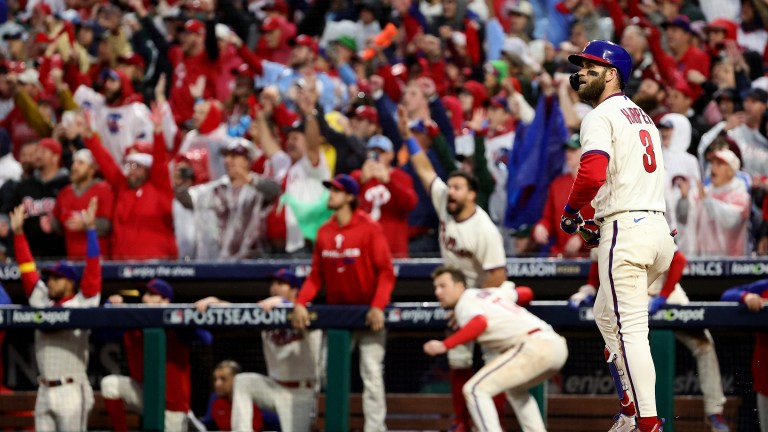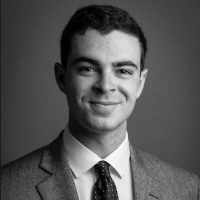Welcome to Bryce Harper’s Magnum Opus
He was a 15-year-old wunderkind, labeled as the baseball equivalent of LeBron James. This October, he's fulfilling that prophecy.

On February 18, 2002, LeBron James, at the time a junior at St. Vincent-St. Mary High School, donned the cover of Sports Illustrated. The cover read three simple words: “The Chosen One.” Two decades later, arguably the greatest athlete to ever pick up a basketball is chasing only Kareem Abdul-Jabbar on the all-time scoring list.
On June 8, 2009, a 16-year-old Bryce Harper donned the cover of Sports Illustrated. SI’s Tom Verducci’s feature on Harper was masterful, but the cover of the issue read eerily similar to one seven years prior: “Baseball’s Chosen One: Bryce Harper is the Most Exciting Prodigy Since LeBron.”
A National League Rookie of the Year, two MVP Awards, two Silver Sluggers, seven All-Star appearances, a $330 million contract, and a recently-added NL Pennant later, Harper and James are in eerily similar spots: both have few boundaries left to push, because they’ve already met the other-worldly expectations set for their teenage selves.
And, after Harper’s game-winning two-run home run in the eighth inning in Game Five of the NLCS against the San Diego Padres on Sunday afternoon, he has continued to push the boundaries of what prodigies are “supposed” to have within their realm of possibilities.
Waiting for the Wonder-Boy
One line jumps off the page of Verducci’s feature on a teenage Harper back in 2009: “Golf has Tiger Woods, basketball has LeBron James, hockey had Wayne Gretzky and military history had Alexander the Great, but baseball, like jazz, is a discipline that does not easily engender prodigies.“
Harper was given his golden ticket in 2010, when the Washington Nationals drafted him No. 1 overall out of the College of Southern Nevada. In his full-season debut, Harper hit .318 with a .977 OPS in 72 games in Low-A before getting the bump to Double-A Harrisburg to end the 2011 season. In late April of 2012, Harper made his Major League debut at 19 years and 195 days old.
His maiden season went swimmingly, edging out Arizona’s Wade Miley for Rookie of the Year honors. His age-20 season in 2013 was solid enough, slashing .274/.368/.486 and earning his second All-Star nod. Limited to just 100 games in 2014, Harper ended the year with just a .768 OPS.
A solid statistical start to his colorful career, but worries about his maturity (or lack thereof) and “clown questions” crept into a sport too enamored with the old guard to let a young, fiery, mohawked kid flip it upside down.
Until he flipped it upside down.
In 2015, Harper won his first MVP award, slashing .330/.460/.649 with 42 home runs, 99 RBIs, and 124 walks in 147 games as a 22-year-old. In a sink-or-swim league, Harper was wading comfortably through his first three seasons. During his MVP campaign, he shot out of the water and left it far behind.
What Was Missing?
The counting numbers continued to accumulate through Harper’s illustrious twenties. Four more All-Star games, another 1.000 OPS season in 2017, and countless moonshots that brought crowds to their feet. Ahead of the 2019 season, Harper inked one of the largest deals in North American sports history to this day, signing for 13 years and $330 million with the Philadelphia Phillies.
Again, the numbers have never faltered. On the heels of his second MVP season in 2021 and an MVP-caliber regular season shortened by a thumb injury this year, Harper’s a career .280 hitter with a .390 OBP, .913 OPS, 285 home runs, and 42.5 bWAR across 11 big league seasons.
But, Harper’s Nationals teams never made it past the NLDS in his four trips. In his first season away from Washington, his former club hoisted a World Series trophy.
His first three seasons in Philadelphia ended before pitchers threw on the turtlenecks and the rally towels came out in postseason crowds. This month’s NL Wild Card Game One in St. Louis was Harper’s first postseason game since October 12, 2017.
Something to Prove
It hasn’t just been a good, or even great, postseason for Bryce Harper; he’s been the best player in baseball over the last three weeks, and it hasn’t been close. In 11 postseason games for the Phillies superstar, Harper has seven multi-hit games, a .419 average, and a 1.351 OPS. His five home runs and 11 RBIs are both tied for the Postseason lead with teammate Rhys Hoskins.
His final at-bat of the NLDS came against Braves closer Kenley Jansen, when he sent an opposite-field home run down the left field line to add to a four-run Phillies lead. In his second at-bat of the NLCS, he sent an outside fastball from Yu Darvish to the front row of the left field bleachers to open scoring in the fourth inning. And, as FOX Sports’ Joe Davis put it, Harper put “the swing of his life” on the final pitch he saw in the National League Championship Series.
Regardless of what happens in the Fall Classic, Harper, who turned 30 years old on October 16, has accomplished all he needs to accomplish. From gracing the cover of the most popular sports magazine in the world before he could see an R-rated movie without adult supervision, to debuting at the highest level of the game before he could sip a beer, to signing a $330 million deal before he was legally obligated to get off of his parents’ insurance plan.
With seemingly impossible expectations, “Baseball’s Chosen One” has supplied a moment, and a career, that few could ever concoct in their dreams.

